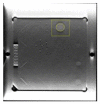Digital Breast Tomosynthesis: Towards Dose Reduction through Image Quality Improvement
- PMID: 37367467
- PMCID: PMC10299507
- DOI: 10.3390/jimaging9060119
Digital Breast Tomosynthesis: Towards Dose Reduction through Image Quality Improvement
Abstract
Currently, breast cancer is the most commonly diagnosed type of cancer worldwide. Digital Breast Tomosynthesis (DBT) has been widely accepted as a stand-alone modality to replace Digital Mammography, particularly in denser breasts. However, the image quality improvement provided by DBT is accompanied by an increase in the radiation dose for the patient. Here, a method based on 2D Total Variation (2D TV) minimization to improve image quality without the need to increase the dose was proposed. Two phantoms were used to acquire data at different dose ranges (0.88-2.19 mGy for Gammex 156 and 0.65-1.71 mGy for our phantom). A 2D TV minimization filter was applied to the data, and the image quality was assessed through contrast-to-noise ratio (CNR) and the detectability index of lesions before and after filtering. The results showed a decrease in 2D TV values after filtering, with variations of up to 31%, increasing image quality. The increase in CNR values after filtering showed that it is possible to use lower doses (-26%, on average) without compromising on image quality. The detectability index had substantial increases (up to 14%), especially in smaller lesions. So, not only did the proposed approach allow for the enhancement of image quality without increasing the dose, but it also improved the chances of detecting small lesions that could be overlooked.
Keywords: digital breast tomosynthesis; dose reduction; image quality; total variation minimization.
Conflict of interest statement
The authors declare no conflict of interest.
Figures









References
-
- Coleman C. Proceedings of the Seminars in Oncology Nursing. Volume 33. Elsevier; Amsterdam, The Netherlands: 2017. Early detection and screening for breast cancer; pp. 141–155. - PubMed
-
- Lewin J.M. Digital mammography. Cancer Imaging. 2008:455–458.
Grants and funding
LinkOut - more resources
Full Text Sources

